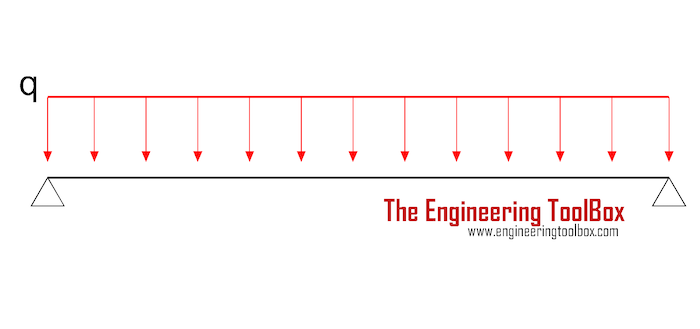Beams Natural Vibration Frequency
Estimate structures natural vibration frequency.
Vibrations in a long floor span and a lightweight construction may be an issue if the strength and stability of the structure and human sensitivity is compromised. Vibrations in structures are activated by dynamic periodic forces - like wind, people, traffic and rotating machinery.
There are in general no problems with vibrations for normal floors with span/dept ratio less than 25. For lightweight structures with span above 8 m (24 ft) vibrations may occur. In general - as a rule of thumb - the natural frequency of a structure should be greater than 4.5 Hz (1/s) .
Structures with Concentrated Mass
f = (1 / (2 π)) (g / δ)0.5 (1)
where
f = natural frequency (Hz)
g = acceleration of gravity (9.81 m/s2)
δ = static dead load deflection estimated by elastic theory (m)
Note! - static dead load for a structure is load due to it's own weight or the weight of mass that is fixed to the structure.
Structures with Distributed Mass
General rule for most structures
f = a / (δ)0.5 (2)
a = numerical factor (in general 18)
The numerical factor a can be calculated to 15.75 for a single lumped system but varies in general between 16 and 20 for similar systems. For practical solutions a factor of 18 is considered to give sufficient accuracy.
Simply Supported Structure - Mass Concentrated in the Center

For a simply supported structure with the mass - or load due to gravitational force weight - acting in the center, the natural frequency can be estimated as
f = (1 / (2 π)) (48 E I / M L3)0.5 (3)
where
M = concentrated mass (kg)
Simply Supported Structure - Sagging with Distributed Mass

For a simply sagging supported structure with distributed mass - or load due to gravitational force - can be estimated as
f = (π / 2) (E I / q L4)0.5 (4)
Example - Natural Frequency of Beam
The natural frequency of an unloaded (only its own weight - dead load) 12 m long DIN 1025 I 200 steel beam with Moment of Inertia 2140 cm4 (2140×10-8 m4) and Modulus of Elasticity 200×109 N/m2 and mass 26.2 kg/m can be calculated as
f = (π / 2) ((200×109 N/m2) (2140×10-8 m4) / (26.2 kg/m) (12 m)4)0.5
= 4.4 Hz - vibrations are likely to occur
The natural frequency of the same beam shortened to 10 m can be calculated as
f = (π / 2) ((200×109 N/m2) (2140×10-8 m4) / (26.2 kg/m) (10 m)4)0.5
= 6.3 Hz - vibrations are not likely to occur
Simply Supported Structure - Contraflexure with Distributed Mass

For a simply contraflexure supported structure with distributed mass - or dead load due to gravitational force - can be estimated as
f = 2 π (E I / q L4)0.5 (5)
Cantilever with Mass Concentrated at the End

For a cantilever structure with the mass - or dead load due to gravitational force - concentrated at the end, the natural frequency can be estimated as
f = (1 / (2 π)) (3 E I / F L3)0.5 (6)
Cantilever with Distributed Mass

For a cantilever structure with distributed mass - or dead load due to gravitational force - the natural frequency can be estimated as
f = 0.56 (E I / q L4)0.5 (7)
Structure with Fixed Ends and Distributed Mass

For a structure with fixed ends and distributed mass - or dead load due to gravitational force - the natural frequency can be estimated as
f = 3.56 (E I / q L4)0.5 (8)



